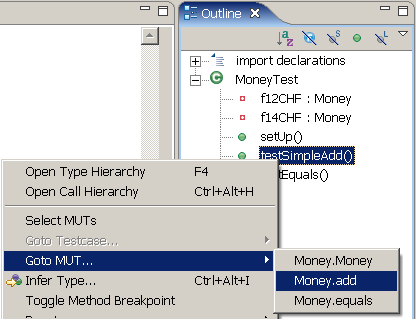 EzUnit — A New View
on Unit Testing in Eclipse
EzUnit — A New View
on Unit Testing in Eclipse EzUnit — A New View
on Unit Testing in Eclipse
EzUnit — A New View
on Unit Testing in Eclipsea framework to link test failures to tested methods, and to report failures as problems analogous to compiler-generated errors and warnings
To
show how EzUnit works we resort to the standard example of JUnit
— class Money
and test class MoneyTest.
We use JUnit 4 and annotate test classes accordingly, basically
because EzUnit also relies on annotations. EzUnit works with
JUnit 3.8 also, but currently requires an @Test annotation to
explicitly mark test methods (the materialization of test cases
in JUnit).
Back to the example. Here is the code:
public class Money {
private int fAmount;
private String fCurrency;
public Money(int amount, String
currency) {
fAmount= amount;
fCurrency= currency;
}
public int amount() {
return fAmount;
}
public Money add(Money m) {
return new
Money(amount()+m.amount(), currency());
}
public boolean equals(Object
anObject) {
if (anObject instanceof
Money) {
Money aMoney= (Money)anObject;
return aMoney.currency().equals(currency())
&& amount() == aMoney.amount();
}
return false;
}
public String currency() {
return fCurrency;
}
}
and
import static
org.junit.Assert.*;
import org.junit.Before;
import org.junit.Test;
public class MoneyTest {
private Money f
private Money f
@Before
public void setUp() throws
Exception {
f
f
}
@Test
public void testSimpleAdd() {
Money expected= new
Money(
Money result= f
assertTrue(expected.equals(result));
}
@Test
public void testEquals() {
assertTrue(!f
assertEquals(f
assertEquals(f
assertTrue(!f
}
}
You can download an Eclipse project containing just the two classes here.
In
unit testing jargon, Money
is what is called a Class Under Test (CUT). We add to this
notion that of a Method Under Test (MUT). The idea is that
test cases call one or more methods of one or more CUTs, but not
all of the called methods are necessarily test candidates, that
is, are actually tested. Unfortunately, for EzUnit there is no
way to tell which methods are, so you will have to name them.
For this, you have to add annotations to test cases that link them to the methods they test. Since this annotating is tedious, you don't have to do it manually — instead, you can select them from a list compiled from the call graph of the test method (test case) and have the annotations generated for you. Here is how it works:
@MUT
annotation type to your project. For this, you have to
enter the Properties page of your project and add
"MUT" to the project's libraries. (A project's
libraries are listed under Java Build Path >
Libraries. Use the Add Library button and select MUT; if
you haven't already done it, use it again to add JUnit
4).select "Money.add(QMoney;)" and confirm.
EzUnit then adds a corresponding annotation, as in
@org.projectory.ezunit.MUT (
This
tells EzUnit that if testSimpleAdd()
fails, Money add(Money)
is the only possible culprit. You could have added other methods
as MUTs (and candidate culprits), but for the example one
suffices.
You
can now run JUnit as usual, and since everything is OK, it will
pass both tests. To see what happens if a test fails, go to Money add(Money), for
instance by selecting "Goto MUT… > Money.add"
from the context menu of testSimpleAdd()
as in

and seed an error, for instance by adding 1 to the sum. When you re-run JUnit, the following will happen:
Money
add(Money), as in
As with compiler-generated errors, double clicking on the Problems entry leads you to the source of the problem, the MUT. Both the gutter annotation and the Problems entry lead you directly to the test case that caused the test run to fail: simply click on the gutter for a Quick Fix, or right click on the info and select Quick Fix.
EzUnit is designed as a framework. This means that EzUnit is to be extended by plug-ins enhancing its functionality. An example can be found here.
@MUT
annotation to a test method (such as testSimpleAdd()
above), upon test failure additional gutter annotations
will appear in corresponding places, and corresponding
entries will be added to the Problems tab. In most cases,
only one of the MUTs will be the culprit, but for the
EzUnit framework, there is no way to tell which one. More
intelligent analyses of where exactly the error is
located are the task of extensions to EzUnit.@MUT
annotations of test cases anytime, either by hand editing
the @MUT
annotation or by calling "Select MUTs" from the
context menu of a test method in an outline view.@MUT
annotation entries) and how possible targets of the above
mentioned gotos are computed.@MUT
annotation in new projects automatically, so you have to
do it by hand (but only once per project).@MUT
annotation entries for methods that do not (or do no
longer) exist are not flagged in any way; also, these
methods are (despite their absence) listed as possible
goto MUT targets. Fixing this would mean to check
annotations at compilation time, which we do not do.@MUT
annotation entries that are not in the call graph of a
test case are not flagged. This would require an analysis
of annotations during compilation; also, it would not
consider possible reflective calls.